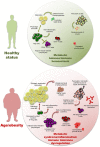Type 2 Diabetes: How Much of an Autoimmune Disease?
- PMID: 31333589
- PMCID: PMC6620611
- DOI: 10.3389/fendo.2019.00451
Type 2 Diabetes: How Much of an Autoimmune Disease?
Abstract
Type 2 diabetes (T2D) is characterized by a progressive status of chronic, low-grade inflammation (LGI) that accompanies the whole trajectory of the disease, from its inception to complication development. Accumulating evidence is disclosing a long list of possible "triggers" of inflammatory responses, many of which are promoted by unhealthy lifestyle choices and advanced age. Diabetic patients show an altered number and function of immune cells, of both innate and acquired immunity. Reactive autoantibodies against islet antigens can be detected in a subpopulation of patients, while emerging data are also suggesting an altered function of specific T lymphocyte populations, including T regulatory (Treg) cells. These observations led to the hypothesis that part of the inflammatory response mounting in T2D is attributable to an autoimmune phenomenon. Here, we review recent data supporting this framework, with a specific focus on both tissue resident and circulating Treg populations. We also propose that selective interception (or expansion) of T cell subsets could be an alternative avenue to dampen inappropriate inflammatory responses without compromising immune responses.
Keywords: T cells; autoimmunity; diabetes; immunometabolism; inflammation.
Figures


References
Publication types
LinkOut - more resources
Full Text Sources
Other Literature Sources

